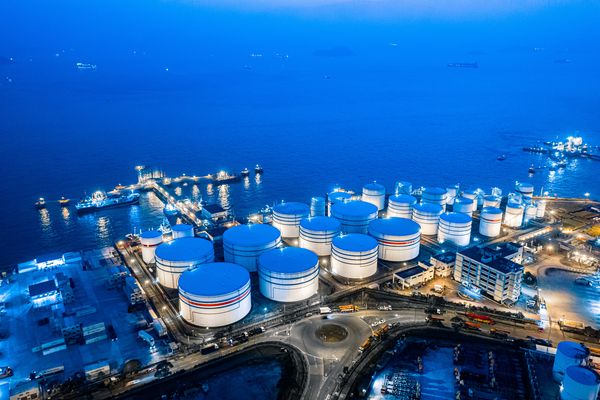The global oil market is shortchanging American oil producers. The primary global benchmark, Brent, was recently around $62 a barrel. The main domestic benchmark, WTI, on the other hand, traded at roughly $53.50 a barrel. Because of that discount, U.S. oil companies are earning about $8.50 less per barrel than their global peers. With oil companies currently pumping out more than 11 million barrels per day (BPD) from beneath U.S. soil, it means they're missing out on nearly $100 million of revenue each day.
The main issue causing the discount in U.S. crude prices is that there isn't enough refining capacity in the country to handle its growing gusher of crude from shale fields. That's leading several energy companies to work on solutions that would narrow the shortfall. The latest entrant in the race to build more export capacity is refining giant Phillips 66 (PSX 1.39%), which is proposing a new deep-water oil export terminal off the coast of Texas. It's the ninth such project aimed at making America an energy export juggernaut.

Image source: Getty Images.
An oil overload
Oil producers in the U.S. have unleashed a spectacular gusher of new oil production in recent years. According to the U.S. Energy Information Administration (EIA), U.S. crude production grew at its fastest pace in history last year, reaching an average of 11 million BPD, which obliterated the record of 9.6 million BPD set in 1970. The country's output is on track to increase by another 1.4 million BPD this year (only slightly slower than last year's record pace) and expand by an additional 900,000 BPD next year, according to the EIA's latest forecast.
While America has 18.6 million BPD of refining capacity, most refiners configured their facilities to process the heavier grades of crude oil produced in Mexico, Venezuela, and Canada. Because of that, they aren't as able to handle the growing volumes of lighter oil that comes from shale formations. While many refineries are working on increasing their ability to process more of this light oil, they can't keep up with supply growth.
Because of that, American energy companies are exporting some of the excess crude oil that's currently weighing down domestic prices. The problem is that there isn't enough capacity to ship this oil to global markets given how fast output is expanding. That's leading a growing number of companies to propose building additional export facilities, which should help ease this glut and improve crude oil pricing in the country.

Image source: Getty Images.
Add another name to the list
Phillips 66 is already working on one export solution. The company's MLP, Phillips 66 Partners, has partnered with refiner Marathon Petroleum (MPC 0.51%) and MLP Buckeye Partners on the South Texas Gateway Terminal. The companies are investing $500 million on the facility near Corpus Christi, which will have the ability to load 800,000 BPD onto tankers. It should be operational by the middle of next year and will receive oil from the Gray Oak Pipeline that Marathon, Phillips 66 Partners, and Enbridge (ENB +0.75%) are building to transport crude from the fast-growing Permian Basin to the U.S. Gulf Coast.
However, Phillips 66 is now proposing to construct the Bluewater Texas Terminal, which would be an export terminal 20 miles off the coast of Corpus Christi. Bluewater would be able to load up to 1.56 million BPD, which could quickly fill a class of tanker called a very large crude carrier (VLCC), capable of transporting 2 million barrels of oil. If approved, it could be in service in mid-2021. That time frame lines up with two oil pipeline projects that Phillips 66 and its partners recently sanctioned, Liberty and Red Oak, which will move oil from places like the Permian Basin and the Bakken shale to the refining and export market along the Texas Coast.
Bluewater, however, faces intense competition since it's now the ninth export project pitched by energy companies. Midstream giant Enterprise Products Partners (EPD +0.56%), for example, is working on the Sea Port Oil Terminal (SPOT), which is a deep-water export terminal off the coast of Houston. Because Enterprise is building that facility offshore, it could also fill VLCCs quickly. Meanwhile, Enbridge is working on a similar offshore terminal, Texas COLT, that it hopes can start up by 2022. Although one of its partners recently walked away from that project, Enbridge sees the $800 million terminal project as an excellent complement to its oil infrastructure in the Gulf region.
There isn't enough room for all of them
U.S. oil companies are producing such a gusher of crude oil that it has overwhelmed the nation's infrastructure to transport and process it. That's costing producers money, which is why the industry is looking to increase its export capacity.
But even with the country's export volumes on track to potentially reach 8 million BPD by 2025 -- up from 3 million BPD this year -- the industry has proposed more projects than it needs to fill this gap. Because of that, it's unlikely that they will all move forward. So investors shouldn't get too excited by Phillips 66's decision to enter this race to capture a slice of America's oil export market, since it's one that the company might not win.








